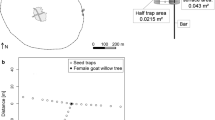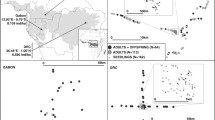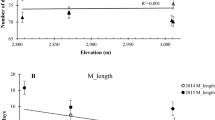Abstract
Seed stand is a natural forest population that is one of the essential seed sources for global seed supply. Individual fertility is an ability to produce progeny to next generation. Prediction of fertility variation is useful for seed quality, ecosystem management and gene conservation. Fertility variation and gene diversity in seed stands of Taurus cedar were estimated based on the difference in strobilus production between female and male parents. A total of 50 trees were randomly chosen from each stand, and female and male strobili were counted for three consecutive years. The mean of female strobili ranged from 31 to 150, and that of male ranged between 77 and 828. The variation in strobilus production was subjected to estimation of female and male fertility variation. The total fertility variation (\(\Psi\)) was estimated from the female and male fertility variation. The \(\Psi\) in a good crop year was smaller than in a poor year. The effective number of parents (Np) was calculated based on the \(\Psi\), which varied from 34.7 to 44.2. When strobilus productions were pooled across 3 years or populations, the Np increased. Equal cone harvest could mitigate the fertility variation among individuals but caused loss of seed production. Mixing seeds from different years could also decrease the fertility variation and increase the gene diversity of seeds. However, a balance between the size of Np and the number of pooling years should be carefully considered for maintaining the gene diversity in the natural stands.



Similar content being viewed by others
Availability of data and materials
The datasets used and/or analyzed during the current study are available from the corresponding author upon reasonable request.
References
Allendorf FW, Luikart GH, Aitken SN (2013) Conservation and the genetics of populations. Wiley, Chichester
Atalay I (1987) General ecological properties of natural occurrence areas of cedar (Cedrus libani A. Rich) forests and regioning of seed transfer of Cedar in Turkey. General Directorate of Forestry press, Ankara
Bila AD (2000) Fertility variation and its effects on gene diversity in forest tree populations. Ph.D. Thesis. Swedish University of Agricultural Science, Acta Universitatis Agriculturae Sueciae, Silvestria 166, Umeå, Sweden
Bilir N (2011) Fertility variation in wild rose (Rosa canina) over habitat classes. Int J Agric Biol 13:110–114
Bilir N, Ozel HB (2017) Fertility variation in a natural stand of Taurus cedar (Cedrus libani A. Rich.). International Forestry and Environment Symposium (IFES), 7–10 November, Trabzon
Bilir N, Kang KS, Lindgren D (2005) Fertility variation in six populations of Brutian pine (Pinus brutia Ten.) over altitudinal ranges. Euphtyica 141:163–168
Boydak M (2003) Regeneration of Lebanon cedar (Cedrus libani A.Rich.) on karstic lands in Turkey. For Ecol Manage 178:231–243
Brown I (1971) Flowering and seed production in grafted clones of Scots pine. Silvae Genet 20:121–132
Chaisurisri K, El-Kassaby YA (1993) Estimation of clonal contribution to cone and seed crops in a Stika spruce seed orchard. Ann Sci For 50:461–467
Charlesworth B, Charlesworth D (2010) Elements of evolutionary genetics. Roberts & Co: Greenwood Village, Colorado, USA
Crow JF, Kimura M (1970) An introduction to population genetics theory. Harper and Row Publishers, London
Eriksson G, Jonsson A, Lindgren D (1973) Flowering in a clonal trial of Picea abies (Karst.). Studia Forestalia Sueccica 110:4–45
Falconer D, Mackay TFC (1996) Introduction to quantitative genetics. Longman, Harlow
General Directorated of Forestry (2015) Forest inventory of Turkey. Ankara, Turkey
General Directorated of Forestry (2020) Seed production areas. Research Directorate of Forest Tree Seeds and Tree Breeding, Ankara, Turkey
Griffin AR (1982) Clonal variation in Radiata pine seed orchards. I. Some flowering, cone and seed production traits. Aust For Res 12:295–302
Kamalakannan R, Varghese M, Park JM, Kwon SH, Song JH, Kang KS (2015) Fertility variation and its impact on effective population size in seed stands of Tamarindus indica and Azadirachta indica. Silvae Genet 64:91–99
Kang KS (2001) Genetic gain and gene diversity of seed orchard crops. Ph.D Thesis. Swedish University of Agricultural Science, Acta Universitatis Agriculturae Sueciae, Silvestria 187, Umeå, Sweden
Kang KS, El-Kassaby YA (2002) Considerations of correlated fertility between genders on genetic diversity: Pinus densiflora seed orchard as a model. Theor Appl Genet 105:1183–1189
Kang KS, Lindgren D (1998) Fertility variation and its effect on the relatedness of seeds in Pinus densiflora, Pinus thunbergii and Pinus koraiensis clonal seed orchards. Silvae Genet 47:196–201
Kang KS, Bila AD, Harju AM, Lindgren D (2003) Fertility variation in forest tree populations. Forestry 76:329–344
Koski V, Antola J (1993) National tree breeding and seed production programme for Turkey 1994–2003. The Research Directorate of Forest Tree Seeds and Tree Breeding, Ankara
Lindgren D, Mullin TJ (1998) Relatedness and status number in seed orchard crops. Can J For Res 28:276–283
Lynch M (2007) The Origins of Genome Architecture. Sinauer Associates
Muller-Starck G, Ziehe M (1984) Reproductive systems in conifer seed orchards. Theor Appl Genet 69:173–177
OECD (1974) Scheme for the certification of forest reproductive material moving in international trade. p 55
Park JM, Kwon SH, Lee HJ, Na SJ, El-Kassaby YA, Kang KS (2017) Integrating fecundity variation and genetic relatedness in estimating the gene diversity of seed crops: Pinus koraiensis seed orchard as an example. Can J For Res 47(3):366–370
Sarvas R (1962) Investigations on the flowering and seed crop of Pinus sylvestris. Commun Inst For Fenn 53
SAS Inst. Inc. (1988) SAS/STAT User’s Guide, Release 6.03, edition, Cary, NC
Savolainen O, Karkkainen K, Harju A, Nikkanen T, Rusanen M (1993) Fertility variation in Pinus sylvestris: a test of sexual allocation theory. Am J Bot 80:1016–1020
Wojacki J, Eusemann P, Ahnert D, Pakull B, Liesebach H (2019) Genetic diversity in seeds produced in artificial Douglas-fir (Pseudotsuga menziesii) stands of different size. For Ecol Manage 438:18–24
Wright S (1931) Evolution in mendelian populations. Genetics 16:97–159
Yazici N, Bilir N (2017) Aspectual fertility variation and its effect on gene diversity of seeds in natural stands of Taurus cedar (Cedrus libani A. Rich.). IJ Genom 2960624:1–5
Zobel BJ, Talbert J (2003) Applied forest tree improvement. Wiley, New York
Acknowledgements
Authors thank the graduate students for their help during data collection and the regional forest directorate in Turkey. This work was supported by the R&D program of Korea Forest Service (Korea Forestry Promotion Institute, Project No. FTIS 2020182B10-2022-BB01), and partly carried out when Prof. Kang was a visiting faculty to UBC, Canada.
Funding
This work was supported by the R&D program of Korea Forest Service (Korea Forestry Promotion Institute, Project No. FTIS 2020182B10-2022-BB01).
Author information
Authors and Affiliations
Contributions
NB conducted fieldwork and data analyses with assistance from K-S and regional forest directorate in Turkey. The manuscript was written by K-S and NB. K-S also developed new equations.
Corresponding author
Ethics declarations
Conflict of interest
The authors declare that they have no competing interests.
Additional information
Communicated by Oliver Gailing.
Publisher's Note
Springer Nature remains neutral with regard to jurisdictional claims in published maps and institutional affiliations.
Rights and permissions
About this article
Cite this article
Bilir, N., Kang, KS. Fertility variation, seed collection and gene diversity in natural stands of Taurus cedar (Cedrus libani). Eur J Forest Res 140, 199–208 (2021). https://doi.org/10.1007/s10342-020-01324-1
Received:
Revised:
Accepted:
Published:
Issue Date:
DOI: https://doi.org/10.1007/s10342-020-01324-1




